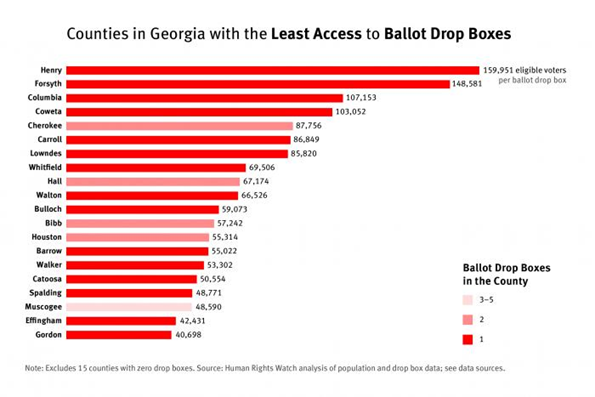December 21, 2020
Honorable Brad Raffensperger
Georgia Secretary of State
214 State Capitol
Atlanta, GA 30334
Re: Increase Ballot Drop Boxes to Ensure the Right to Vote in Georgia’s Runoff Elections
Copied to: All Georgia County Election Supervisors
Dear Secretary of State Raffensperger:
We write to urge you to direct Georgia’s County Election Supervisors to install secure ballot drop boxes and make them accessible to all eligible voters in the state so that they can safely exercise their right to vote in the January 5th runoff elections.
We are grateful for your responsible leadership prior to the November 3 general election, during which, in light of the Covid-19 pandemic, you encouraged eligible voters in Georgia to use absentee voting, including through the use of ballot drop boxes . However, based on a data analysis conducted by the non-partisan human rights organization Human Rights Watch, the inequities in drop box access in the state are pronounced.
The county in which a Georgia citizen resides should not determine whether they can safely cast their ballot. The current distribution of ballot drop boxes in the state creates unequal access to the right to vote in the state. In fact, 15 counties in Georgia do not have a single drop box. Of counties with drop boxes, Henry, Forsyth, Columbia, and Coweta counties are the four least accessible, with just one ballot drop box for 100,000 – 150,000 eligible voters in each county. Quitman, Webster, Clay, and Baker counties are the four most accessible, with one for every 2,000 eligible voters. Figures 1, 2, and 3 enclosed below show the extreme maldistribution of drop boxes between Georgia counties.
As you know, the new Covid-19 case rate in Georgia is increasing in many counties, yet many of these counties have an extreme shortage of accessible ballot drop boxes. Figure 4 below shows the counties with the highest rates of Covid-19 new case rates, using data from mid-November. Out of the 30 counties in Georgia with the highest rates at that time, the vast majority (22 counties) have only one ballot drop box. Two counties out of the 30 do not have a single drop box.
Ballot drop boxes have been used in the United States for decades. As you have recognized, they offer a very efficient means by which voters can have visual confirmation that their ballots have been cast, but they avoid the crowds, wait times, and proximity between people that can characterize in-person voting at polling stations, and which is not advisable due to the Covid-19 pandemic.
Unfortunately, there are many counties in Georgia in which people have to travel extremely long distances in order to cast their ballots safely. This argues for an increase in the number of ballot drop boxes in many counties in the state. As illustrated in Figure 5, below, of the 30 geographically largest counties in the state, about three-quarters, or 22, had only one drop box. An extreme example is Burke County, with one drop box per 827 square miles. One large county, Meriwether, does not have a single drop box. In Georgia, according to 2017 data, 7 percent of all households and 12 percent of Black households did not have access to a vehicle, making these distances especially problematic for absentee voters, given the lack of public transport, especially in rural areas.
Regardless of where they live in Georgia, whether they are rural or urban, Black or white, and regardless of political party, all voters deserve equal access to safe and secure voting. We urge you to work with county officials throughout the state to install more ballot drop boxes and ensure that they are accessible at all times so voters with varying schedules can cast their ballots when they are able to do so.
Please do not hesitate to contact Alison Parker, managing director of the US Program at Human Rights Watch at parkera@hrw.org or (917) 535-9796 should you have any questions regarding this letter. The data tables and full data set can be accessed by following this link: https://media.hrw.org/preview/2627/us-ensure-equitable-voting-access-in-georgia-runoffs/eng .
Sincerely yours,
Alison Leal Parker
Managing Director,U.S. Program
Human Rights Watch
415-801-7305
917-535-9796
Aklima Khondoker
Georgia State Director
All Voting is Local
The Leadership Conference on Civil and Human Rights
678-628-8298
Pichaya Poy Winichakul, Staff Attorney
Voting Rights Practice Group
SPLC Action Fund
PO Box 1287
Decatur, GA 30031-1287
470-597-3010
Alicia Stallworth
Georgia State Director
Planned Parenthood Southeast
Planned Parenthood Southeast Advocates
Jerry Gonzalez
Chief Executive Officer
GALEO & GALEO Latino CommunityDevelopment Fund
Board Member of the GALEO Impact Fund, Inc.
Susannah E. Scott, President
League of Women Voters of Georgia
cc: All Georgia County Election Supervisors, via email
Enclosed: Data Figures
Data Figures: Inequities in Eligible Voters’ Access to Ballot Drop Boxes in Georgia
Figure 1 – Distribution of Georgia Ballot Drop Boxes
| Number of Ballot Drop Boxes in County | Number of Georgia Counties in Category | Eligible Voters Living in Counties | Percentage of Eligible Voters Living in Counties |
| 0 | 15 | 149,921 | 2% |
| 1 | 107 | 2,494,837 | 33% |
| 2-5 | 28 | 1,781,461 | 24% |
| 6-10 | 4 | 574,930 | 8% |
| >10 | 5 | 2,536,813 | 34% |
Figure 2 – Map of Georgia Ballot Drop Box Distribution by County

Figure 3.

Figure 4.

Figure 5.

